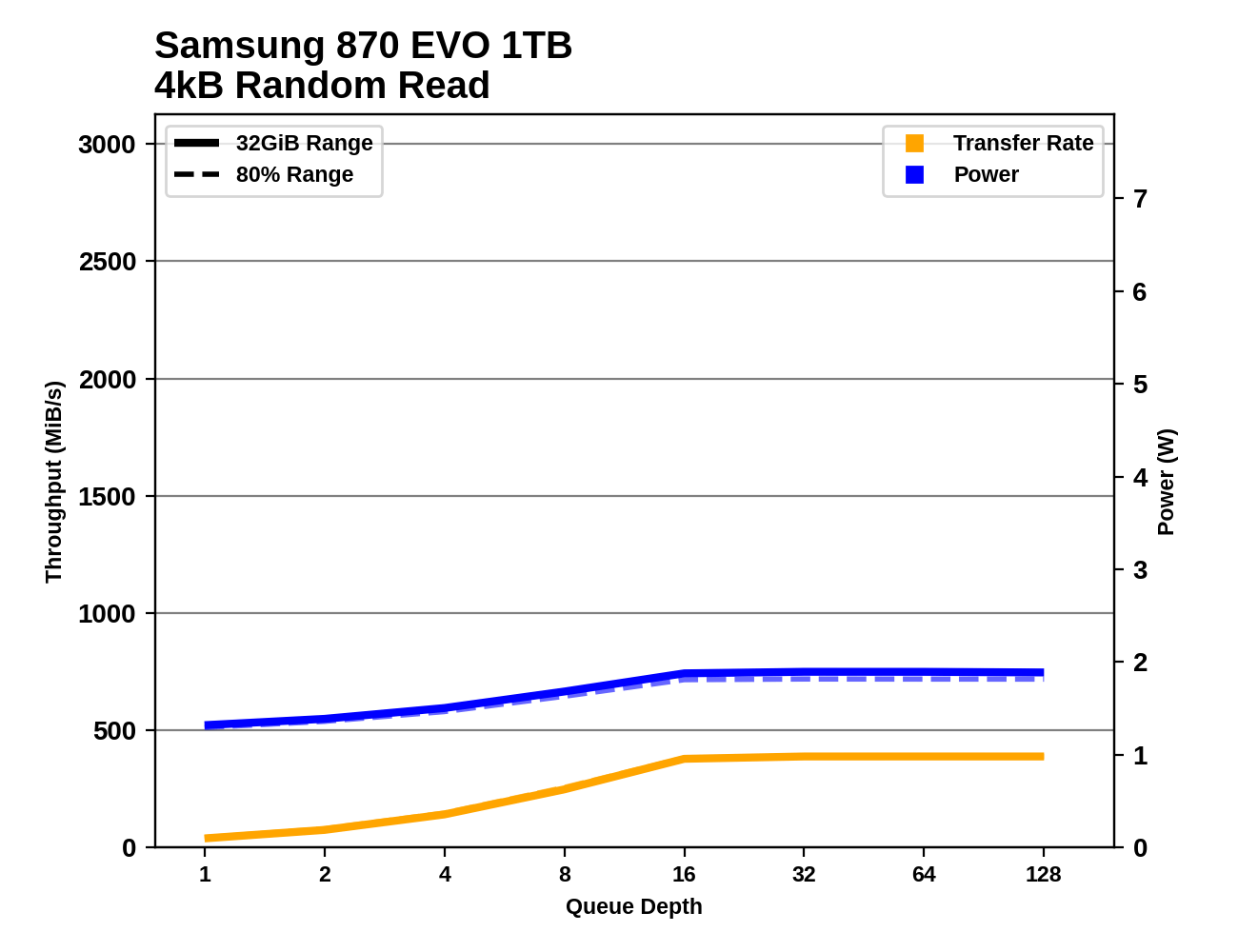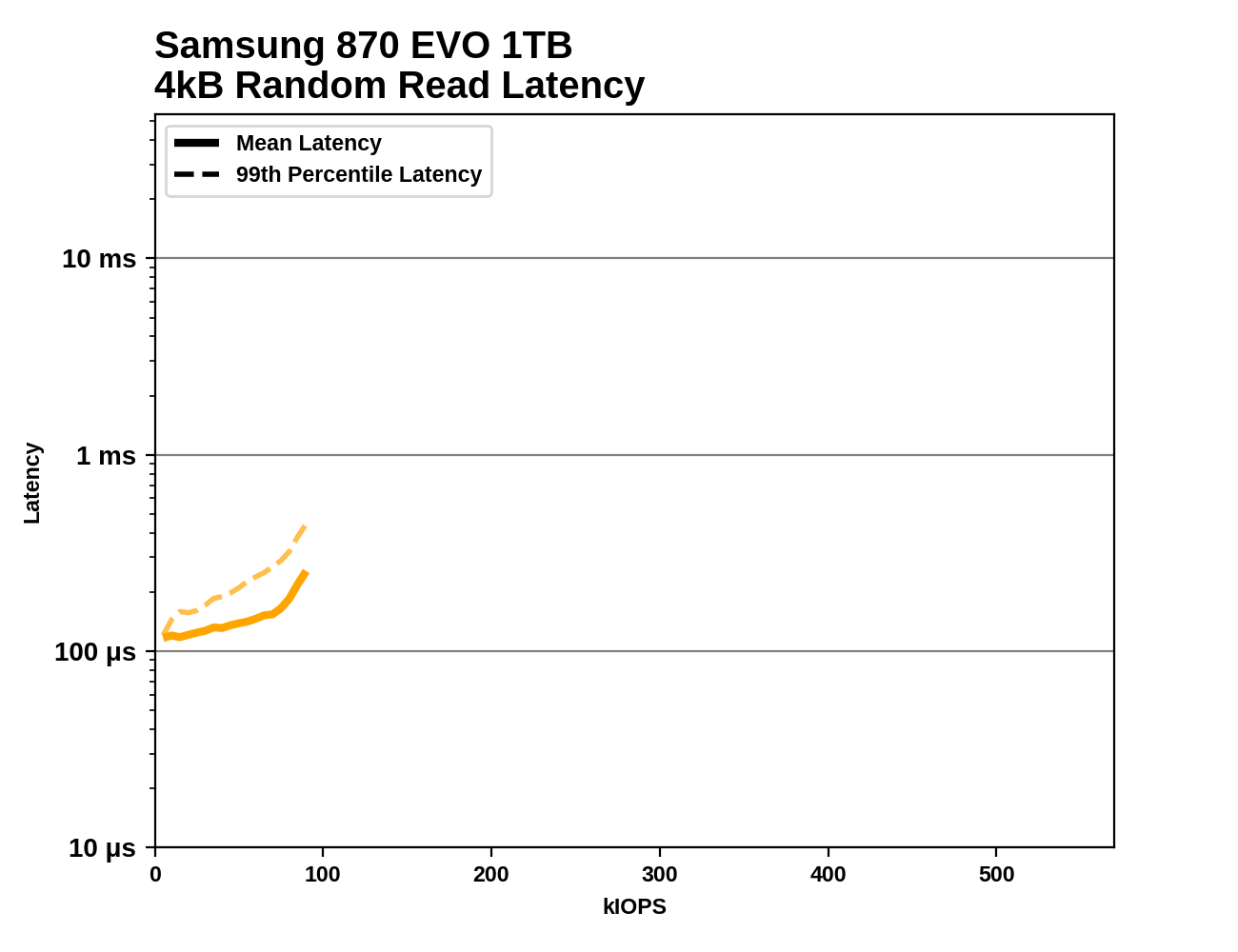The Samsung 870 EVO (1TB & 4TB) Review: Does the World Need Premium SATA SSDs?
by Billy Tallis on February 17, 2021 8:00 AM ESTBurst IO Performance
Our burst IO tests operate at queue depth 1 and perform several short data transfers interspersed with idle time. The random read and write tests consist of 32 bursts of up to 64MB each. The sequential read and write tests use eight bursts of up to 128MB each. For more details, please see the overview of our 2021 Consumer SSD Benchmark Suite.
 |
|||||||||
| Random Read | Random Write | ||||||||
| Sequential Read | Sequential Write | ||||||||
Our burst IO tests show little to no performance differences between the Samsung 870 EVO and other top SATA SSDs. The 1MB sequential transfers are already hitting the SATA throughput limits even at QD1, and the 4kB random IOs are at best marginally improved over Samsung's previous generation. Samsung's slight improvement to random read latency is enough to catch up to Micron's as shown by the Crucial MX500, but a 10% gain hardly matters when NVMe drives can double this performance.
Sustained IO Performance
Our sustained IO tests exercise a range of queue depths and transfer more data than the burst IO tests, but still have limits to keep the duration somewhat realistic. The primary scores we report are focused on the low queue depths that make up the bulk of consumer storage workloads. For more details, please see the overview of our 2021 Consumer SSD Benchmark Suite.
 |
|||||||||
| Random Read | Random Write | ||||||||
| Sequential Read | Sequential Write | ||||||||
On the longer synthetic tests that bring in some slightly higher queue depths, the improved random read performance of the 870 EVO is a bit more clear. In one sense it is impressive to see Samsung squeeze a bit more performance out of the same SATA bottleneck, but we're still talking about small incremental refinements where NVMe enables drastic improvements. Aside from random reads, the 870 EVO's performance improvements are exceedingly minute and it should be considered essentially tied with most other recent mainstream TLC SATA drives.
 |
|||||||||
| Random Read | Random Write | ||||||||
| Sequential Read | Sequential Write | ||||||||
Power consumption is one area where Samsung could theoretically offer more significant improvements despite still being constrained by the same SATA interface, but the 870 EVO doesn't really deliver any meaningful improvements there. The 4TB model is consistently a bit less efficient than the 1TB model on account of having more memory to keep powered up, but when comparing the 1TB model against its predecessor and competing drives there's nothing particularly noteworthy about the 870 EVO. SK hynix's Gold S31 has a modest efficiency advantage for random IO while Samsung is technically the most efficient of these SATA drives for sequential IO.
 |
|||||||||
| Random Read | |||||||||
| Random Write | |||||||||
| Sequential Read | |||||||||
| Sequential Write | |||||||||
The queue depth scaling behavior of the 870 EVOs is almost identical to the 860 EVOs and still quite typical for mainstream SATA drives. For random reads the 870 EVOs saturate around QD16, while for random writes QD4 suffices. On the sequential IO tests there's only a small performance gain from QD1 to QD16, and the more interesting question is how stable performance is through the rest of the sequential tests. The 1TB 870 EVO seems to run out of SLC cache a bit earlier than the 860 EVO when the sequential write test is running on an 80% full drive, but the 4TB model has plenty of cache to finish out that test at full speed.
Random Read Performance Consistency
This test illustrates how drives with higher throughput don't always offer better IO latency and Quality of Service (QoS), and that latency often gets much worse when a drive is pushed to its limits. This test is more intense than real-world consumer workloads and the results can be a bit noisy, but large differences that show up clearly on a log scale plot are meaningful. For more details, please see the overview of our 2021 Consumer SSD Benchmark Suite.
 |
|||||||||
Consistent with most of our other read performance tests, the Samsung 870 EVO shows slightly better average and 99th percentile random read latencies than most of its SATA competition. Even some of the entry-level NVMe drives that can deliver higher random read throughput than is possible for the 870 EVO still have clearly higher latency across most or all of the throughput range that the 870 EVO can cover. A QLC-based or DRAMless TLC NVMe SSD can potentially offer far higher throughput than any SATA SSD, but clearly beating the 870 EVO on both throughput and latency requires stepping up to a more mainstream NVMe design with DRAM and TLC NAND.










136 Comments
View All Comments
Spunjji - Friday, February 19, 2021 - link
They won't be using SATA - and it will be spread across a whole lot more than one single drive.dotjaz - Friday, February 19, 2021 - link
But they are using SATA, nobody said it's single drive. It's how much storage you can fit into a 1U rack that matters, SATA is the only choice at the moment.schujj07 - Wednesday, February 17, 2021 - link
That is 100% false. NVMe is only surface area limited in the M.2 form factor. However, 99% of users do not need more than a 4TB NVMe SSD. Those that need larger drives can use M.2 > U.2 converters and get much larger SSDs.Beaver M. - Wednesday, February 17, 2021 - link
Yeah well, look into most SATA SSDs, their PCB isnt bigger than that of a M.2 SSD. Plus M.3 is coming = more space.Also theres U.2, which pretty much allows to use 2.5"-sized SSDs to be used (even on a M.2 connector).
SATA is dead. And they know it, else they would have released a new standard very long ago.
nevcairiel - Wednesday, February 17, 2021 - link
The solution to that is called U.2, NVMe with a cable.flgt - Wednesday, February 17, 2021 - link
^^^CaedenV - Wednesday, February 17, 2021 - link
not really? You are typically limited to 8 or 16 chips with most SSDs, and you can hold that on a long double-sided m.2 just fine. If you are going with more than that then you are looking something extremely custom with a built in raid of some sort and that is going to be stupidly expensive and not for the consumer market.Just look at the pic of that 4TB board. Maybe 4 storage modules in it assuming there are 2 more on the other side? You can easily fit that on m.2 with room to spare.
flyingpants265 - Thursday, February 18, 2021 - link
Storage in general is kinda dead. People buy 2tb drives very reluctantly if they want to add space.DanNeely - Wednesday, February 17, 2021 - link
SATA as an SSD interface is going nowhere. SATA as an HDD interface probably has 5-10 years left before the price crossover finally kills spinning rust off.If at some point in the future we do see a new SATA spec; it'll be because mass market spinning rust for NASes has gotten fast enough to bottleneck: In which case they'll backport the faster transport parts of the 2x as fast SAS standard to make SATA4.
wicketr - Wednesday, February 17, 2021 - link
SATA at this point is need of major changes to keep up. They can't do a minor refresh at this point. With that in mind, I hope they change the cable so that it incorporates power into it as well. And they've got to shoot for something like 50Gb/s.At this point the latest USB spec is faster and provides power in a similar sized port. SATA should be able to beat that and it's a shame they haven't done so yet.